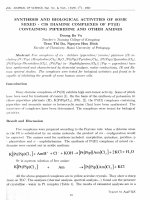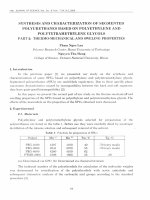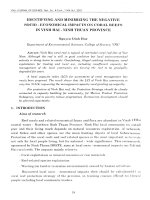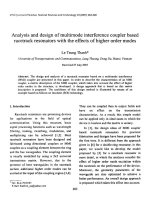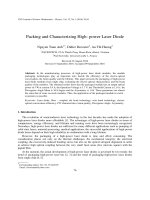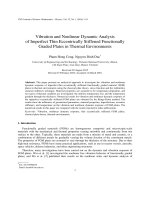DSpace at VNU: Micro and nano liposome vesicles containing curcumin for a drug delivery system
Bạn đang xem bản rút gọn của tài liệu. Xem và tải ngay bản đầy đủ của tài liệu tại đây (3.81 MB, 7 trang )
Home
Search
Collections
Journals
About
Contact us
My IOPscience
Micro and nano liposome vesicles containing curcumin for a drug delivery system
This content has been downloaded from IOPscience. Please scroll down to see the full text.
2016 Adv. Nat. Sci: Nanosci. Nanotechnol. 7 035003
( />View the table of contents for this issue, or go to the journal homepage for more
Download details:
IP Address: 80.82.78.170
This content was downloaded on 12/01/2017 at 09:49
Please note that terms and conditions apply.
You may also be interested in:
Thermosensitive gemcitabine-magnetoliposomes for combined hyperthermia and chemotherapy
Roberta V Ferreira, Thaís Maria da Mata Martins, Alfredo Miranda Goes et al.
Small unilamellar liposomes as a membrane model for cell inactivation by cold atmospheric plasma
treatment
S Maheux, G Frache, J S Thomann et al.
The dual effect of curcumin nanoparticles encapsulated by 1-3/1-6 -glucan from medicinal mushrooms
Hericium erinaceus and Ganoderma lucidum
Mai Huong Le, Hai Doan Do, Hong Ha Tran Thi et al.
Two cholesterol derivative-based PEGylated liposomes as drug delivery system, study on
pharmacokinetics and drug delivery to retina
Shengyong Geng, Bin Yang, Guowu Wang et al.
Electroformation of giant liposomes in microfluidic channels
K Kuribayashi, G Tresset, Ph Coquet et al.
Upconverting crystal/dextran-g-DOPE with high fluorescence stability for simultaneous photodynamic
therapy and cell imaging
HanJie Wang, Sheng Wang, Zhongyun Liu et al.
Curcumin as fluorescent probe for directly monitoring in vitro uptake of Curcumin combined
Paclitaxel loaded PLA-TPGS nanoparticles
Hoai Nam Nguyen, Phuong Thu Ha, Anh Sao Nguyen et al.
Encapsulation of curcumin in polyelectrolyte nanocapsules and their neuroprotective activity
Krzysztof Szczepanowicz, Danuta Jantas, Marek Piotrowski et al.
|
Vietnam Academy of Science and Technology
Advances in Natural Sciences: Nanoscience and Nanotechnology
Adv. Nat. Sci.: Nanosci. Nanotechnol. 7 (2016) 035003 (6pp)
doi:10.1088/2043-6262/7/3/035003
Micro and nano liposome vesicles
containing curcumin for a drug delivery
system
Tuan Anh Nguyen, Quan Duoc Tang, Duc Chanh Tin Doan and
Mau Chien Dang
Laboratory for Nanotechnology, Vietnam National University, Community 6, Linh Trung Ward, Thu Duc
District, Ho Chi Minh City, Vietnam
E-mail:
Received 6 May 2016
Accepted for publication 16 May 2016
Published 5 July 2016
Abstract
Micro and nano liposome vesicles were prepared using a lipid film hydration method and a
sonication method. Phospholipid, cholesterol and curcumin were used to form micro and nano
liposomes containing curcumin. The size, structure and properties of the liposomes were
characterized by using optical microscopy, transmission electron microscopy, and UV–vis and
Raman spectroscopy. It was found that the size of the liposomes was dependent on their
composition and the preparation method. The hydration method created micro multilamellars,
whereas nano unilamellars were formed using the sonication method. By adding cholesterol, the
vesicles of the liposome could be stabilized and stored at 4 °C for up to 9 months. The liposome
vesicles containing curcumin with good biocompatibility and biodegradability could be used for
drug delivery applications.
Keywords: microliposome, nanoliposome, curcumin, drug delivery
Classification numbers: 2.04
1. Introduction
either encapsulated in aqueous space or insert themselves in
the phospholipid bilayer. Liposomes containing drugs have
been studied and applied as a delivery system for treatment of
various diseases [3–7].
Curcumin, a yellow natural polyphenol, is obtained from
Curcuma longa L and also called turmeric. In ancient India,
turmeric was thought to have many healthy properties [8].
Curcumin is known to exhibit anticancer, antioxidant, antiinflammatory, antibacterial and wound-healing properties
with low cytotoxicity [9]. However, it is insoluble in water
and degrades in certain pH conditions. This causes reduced
bioavailability of curcumin in the human body, leading to low
intrinsic activity, poor absorption and high rate of elimination
[10]. To overcome the problems of poor solubility and low
bioavailability, many delivery systems of curcumin have been
developed. Curcumin encapsulated in liposome [11], microparticle-based on albumin [12], chitosan [13], polymer PLGA
[14], etc have been reported. Liposomes containing curcumin
can be administrated by many routes (oral, intravenous,
transdermal, etc) and protect curcumin from degradation.
In 1965, the first description of tiny close-membraned vesicles
of lipids was reported [1]. They were an aqueous volume
enclosed by a bilayer lipid membrane, composed of phospholipid and cholesterol, and called a ‘liposome’. There are
many types of liposome based on the size and number of
lamellae of lipid vesicles. Multilamellar liposome vesicles
(MLVs) usually range from 500 to 10 000 nm. Unilamellar
liposomes can be defined as small (SUV, 20–100 nm), large
(LUV, >100 nm) and very large (giant liposome, >1000 nm)
[1–4].
Liposomes have been considered as a ‘magic bullet’
because they can encapsulate hydrophilic and lipophilic
drugs. In a spherical structure, the drug moleculars can be
Original content from this work may be used under the terms
of the Creative Commons Attribution 3.0 licence. Any
further distribution of this work must maintain attribution to the author(s) and
the title of the work, journal citation and DOI.
2043-6262/16/035003+06$33.00
1
© 2016 Vietnam Academy of Science & Technology
Adv. Nat. Sci.: Nanosci. Nanotechnol. 7 (2016) 035003
T A Nguyen et al
Table 1. Lipid composition and mean diameter of the liposomes prepared by the hydration method.
DOPE:CHOL (wt/wt)
10:1
5:1
3.33:1
2.33:1
Mean diameter (μm)
2.428 ± 0.471
2.797 ± 1.050
2.944 ± 1.560
2.535 ± 0.601
Figure 1. Images of the DOPE liposomes (left) and size distribution of the liposomes (right) with different DOPE:CHOL ratios: (a) DOPE:
CHOL = 10:1, (b) DOPE:CHOL = 5:1, (c) DOPE:CHOL = 3.33:1 and (d) DOPE:CHOL = 2.33:1.
2
Adv. Nat. Sci.: Nanosci. Nanotechnol. 7 (2016) 035003
T A Nguyen et al
Figure 2. Images of the DOPE liposomes without cholesterol (top) and with cholesterol (10:1) (bottom) after storage for 1, 1.5, 3 and 9
months.
2. Experimental
2.1. Materials
1,2-dioleoyl-sn-glycero-3-phosphoethanolamine
(DOPE),
cholesterol (CHOL) and curcumin (Cur) were purchased from
Sigma-Aldrich, US. Chloroform (99.3%–99.5%) was purchased from Prolabo, Germany. De-ionized (DI) water and
phosphate buffered saline (1.0 M, pH 7.4, Sigma-Aldrich)
were used for the experiments. All chemicals used in the
experiments were of pharmaceutical standard and analytical
grade.
The reagents (DOPE, CHOL or Cur) were dissolved in
chloroform with the ratio of 1 mg per ml solvent. All the
solutions were stored at −20 °C before use.
2.2. Lipid hydration method
Figure 3. The mean diameter of liposomes after storage for 1, 1.5, 3
DOPE and CHOL solutions (1 mg ml−1) were mixed in a
round-bottom flask with 5 ml chloroform. The weight ratios
(wt/wt) of DOPE:CHOL were different (table 1). The flask
was attached to a rotary vacuum evaporator (RV06, IKA,
Malaysia) at 50 °C and 50 rpm. After the evaporation process
(2 h), a dry lipid film was formed on the flask wall. The
hydration step was carried out by cracking the lipid layer in
DI water at 40 °C for 1 h and then kept overnight at room
temperature.
and 9 months.
Various methods of liposome preparation have been
reported [15–18]. In this report, liposomes were prepared
using the lipid film hydration method and sonication method.
The hydration method is used for preparation of MLV liposomes [16, 17] and sonication is used for preparation of SUV
liposomes [17–19]. With this synthesis approach, curcumin
was contained inside the end-closed liposome. The size and
structure of the liposomes were characterized by optical
microscopy, transmission electron microscopy (TEM), and
UV–vis and Raman spectroscopy.
2.3. Sonication method
In this method, the hydration step was replaced by a sonication method. After a dry lipid was formed, DI water was
3
Adv. Nat. Sci.: Nanosci. Nanotechnol. 7 (2016) 035003
T A Nguyen et al
Figure 4. Images of LIPS@CUR prepared by (a) the hydration method: optical microscopy image with a mean diameter of (4.139 ± 1.734)
μm and (b) the sonication method: TEM image with a mean diameter of (95.225 ± 6.901) nm.
added to the flask. The liposome (LIPS) was then prepared by
sonication with a bath type sonicator for 10 min. The lipid
layer was cracked into the nano-patches by cavitation under
an inert atmosphere. This was the main method for downsizing multilamellar (micrometer range) vesicles into nanoscaled unilamellar vesicles [20].
Finally, all suspensions were kept at 4 °C for further
experiments.
1.50). The properties of the liposomes without curcumin and
the liposomes containing curcumin were studied by using a
UV–vis spectrometer (CARY 100, Varian, Germany). Raman
spectroscopy (LABRam 300, Horiba, France) was used to
determine the forms of curcumin.
2.4. Preparation of curcumin loaded liposomes
3.1. Size and structure of the liposomes prepared by the
hydration method
3. Results and discussion
Curcumin loaded liposomes were prepared for both the
hydration and sonication methods. Curcumin was mixed with
the DOPE and CHOL solutions in the flask with a weight
ratio of curcumin/liposome of 1:10 in weight (the weight of
liposome is the amount of DOPE and CHOL).
The addition of cholesterol with different concentrations
has various effects on the capacity of the liposomes to
encapsulate and deliver a drug [7]. For preparation of the
curcumin loaded liposomes, a weight ratio of 2.33:1 (the same
proportion of cholesterol in the cell membrane) was used.
Figure 1 shows images of the DOPE liposomes and size
distribution of the liposomes with different DOPE:CHOL
ratios. The mean diameter and the composition of the phospholipids are shown in table 1. The size of the liposomes was
characterized by optical microscopy (figure 2). The results
show that the mean diameter of the liposomes does not
depend on the lipid composition of the liposomes. The multilamellar vesicles (3–10 lipid bilayers) of the liposomes that
were formed by using the hydration method were observed, as
in previous studies [1, 16–19].
Without cholesterol, lipid vesicles might be created but
then the structures were easily destroyed (as shown in figure 2,
top). The cholesterol was added to the formulations of the
liposomes to stabilize the phospholipid layers. This is consistent
with observations for the role of cholesterol in liposomes [21–
23]. The liposomes with cholesterol were then stored for a
2.5. Characterization
The size and structure of the liposomes were characterized by
an optical microscope (GX41, Olympus, Japan) and TEM
(JEM1010, JEOL, Japan). The diameter and distribution of
the liposomes were investigated by ImageJ software (Ver
4
Adv. Nat. Sci.: Nanosci. Nanotechnol. 7 (2016) 035003
T A Nguyen et al
Figure 5. (a) Chemical structure and (b) Raman spectra of curcumin.
Figure 6. UV–vis spectra of (a) liposome and (b) liposome containing curcumin.
longer time (as shown in figure 2, bottom). In this study, the
liposomes (DOPE = 10:1) could be stored at 4 °C for up to 9
months. During storage, these small liposomes agglomerated
together to form larger forms. It was found that the mean diameter of the liposomes increased linearly with time (figure 3).
3.3. Raman and UV–vis spectra
The structure of curcumin was investigated by Raman
spectroscopy (figure 5). The chemical structure of curcumin is
[1,7-bis(4-hydroxy-3-methoxyphenyl)-1,6-heptadiene-3,5dione], commonly called diferuloylmethane (figure 5(a)). In
curcumin, (–OH) and (–OCH3) groups have important
implications regarding preferred molecular structures.
The strong peak between 1600 and 1630 cm−1 was
attributed to the mixed ν(C=C) and ν(C=O) vibration mode
[24–26]. They were observed at 1601 cm−1 (aromatic C=C)
and 1626 cm−1 (carbonyl C=O). The peak at 1430 cm−1 was
the characteristic peak of phenol C–O [24–26]. While two
forms of curcumin structures are defined by the peak at
1249–1250 cm−1, the keto-enol form of curcumin was
obtained at 1250 cm−1 in the spectrum. In addition, a methoxy group (R–OCH3) was vibrated at 573 cm−1.
UV–vis spectroscopy was carried out in the wavelength
range from 200 to 600 nm (figure 6). Absorption of the
liposomes was obtained from 190 to 210 nm, depending on
the size of the nanoparticles [27–30]. The micro-MLVs of
DOPE liposomes had an absorption peak at 210 nm. On the
3.2. Liposome containing curcumin
In this section, curcumin was added in both methods,
hydration and sonication, with the weight ratio of 7:3 (DOPE:
CHOL). The liposomes containing curcumin (LIPS@CUR)
were observed by optical microscopy and TEM. The results
showed that the mean size of LIPS@CUR was larger than the
mean size of liposomes without curcumin (figure 4). This
proved that the presence of curcumin in liposomes increased
the size of the vesicles.
Using the sonication method, the size of LIPS@CUR
decreased by about four times, from 4.1 μm to 95 nm, and the
micro multilamellar liposomes vesicles were changed into
nano unilamellar vesicles, which was also observed in the
previous studies [17–20].
5
Adv. Nat. Sci.: Nanosci. Nanotechnol. 7 (2016) 035003
T A Nguyen et al
[7] Pattni B S, Chupin V V and Torchilin V P 2015 Chem. Rev.
115 10938
[8] Schwab M 2012 Encyclopedia of Cancer (Berlin: Springer)
[9] Anand P, Kunnumakkara A B, Newman R A and
Aggarwal B B 2007 Mol. Pharm. 4 807
[10] Basniwal R K, Buttar H S, Jain V K and Jain N 2011 J. Agr.
Food Chem. 59 2056
[11] Dhule S S, Penfornis P, He J, Harris M R, Terry T, John V and
Pochampally R 2014 Mol. Pharm. 11 417
[12] Gupta V 2009 Int. J. Nanomedicine 4 115
[13] Das R K, Kasoju N and Bora U 2010 Nanomedicine:
Nanotechnology, Biology and Medicine 6 153
[14] Yallapu M M, Gupta B K, Jaggi M and Chauhan S C 2010
J. Colloid Interf. Sci. 351 19
[15] Szoka F Jr and Papahadjopoulos D 1980 Annual Rev. Biophys.
Bioeng. 9 467
[16] Lichtenberg D and Barenholz Y 1988 Methods Biochem. Anal.
33 337
[17] Riaz M 1996 Pak. J. Pharm. Sci. 9 65
[18] Akbarzadeh A, Rezaei-Sadabady R, Davaran S, Joo S W,
Zarghami N, Hanifehpour Y, Samiei M, Kouhi M and
Nejati-Koshki K 2013 Nanoscale Res. Lett. 8 102
[19] Ruysschaert T, Germain M, Da Silva Gomes J F P, Fournier D,
Sukhorukov G B, Meier W and Winterhalter M 2004 IEEE
Transactions on NanoBioscience 3 49
[20] Schroeder A, Kost J and Barenholz Y 2009 Chem. Phys. Lipids
162 1
[21] Johnson S M, Bangham A D, Hill M W and Korn E D 1971
Biochimica et Biophysica Acta (BBA)—Biomembranes
233 820
[22] Faiman R 1977 Chem. Phys. Lipids 18 84
[23] Bicknell-Brown E and Brown K G 1980 Biochem. Biophys.
Res. Commun. 94 638
[24] Sailer K, Viaggi S and Nüsse M 1997 Biochimica et
Biophysica Acta (BBA)-Biomembranes 1329 259
[25] Gardikis K, Hatziantoniou S, Viras K and Demetzos C 2006
Thermochim. Acta 447 1
[26] Gala U and Chauhan H 2015 Expert Opinion on Drug
Discovery 10 187
[27] Monnard P-A, Oberholzer T and Luisi P 1997 Biochimica et
Biophysica Acta (BBA)—Biomembranes 1329 39
[28] Paasonen L, Laaksonen T, Johans C, Yliperttula M,
Kontturi K and Urtti A 2007 J. Control. Release 122 86
[29] Haiss W, Thanh N T K, Aveyard J and Fernig D G 2007 Anal.
Chem. 79 4215
[30] Amendola V and Meneghetti M 2009 J. Phys. Chem. C
113 4277
[31] Benassi R, Ferrari E, Lazzari S, Spagnolo F and Saladini M
2008 J. Mol. Struct. 892 168
other hand, the peak of LIPS@CUR was shifted to
194.74 nm, corresponding to the nanoscale of the vesicles.
The peak of curcumin was at 420 nm, which was in good
agreement with the literature values [31].
4. Conclusion
In this study micro and nano liposomes were prepared using
the lipid hydration and sonication methods. It was found that
the mean size of the liposomes depended on their composition
and the preparation method. Micro multilamellars were
formed using the hydration method while nano unilamellars
were prepared using the sonication method. The structure of
the curcumin, liposomes and liposomes containing curcumin
were investigated by UV–vis and Raman spectroscopy, and
optical microscopy. The mean diameter of the LIPS@CUR
was 4.1 μm and 95 nm (corresponding to the hydration/
sonication method, respectively), which could be stabilized at
4 °C for a long time (up to 9 months in this study). The
curcumin loaded liposomes, coupled with biocompatibility
and biodegradability, could be feasible for drug delivery
purposes.
Acknowledgments
This research is funded by Vietnam National University Ho Chi
Minh City (VNU-HCM) under grant number C2013-32-03.
References
[1] Bangham A D 1993 Chem. Phys. Lipids 64 275
[2] Widder K J 1985 J. Pharm. Sci. 74 701
[3] Kaur L, Kaur P and Khan M 2013 Int. J. Res. Pharm. Chem.
3 121
[4] Allen T M and Cullis P R 2013 Adv. Drug Delivery Rev. 65 36
[5] Rani D 2013 Int. Res. J. Pharm. 4 1
[6] Çağdaş M, Sezer A D and Bucak S 2014 Liposomes as
potential drug carrier systems for drug delivery Application
of Nanotechnology in Drug Delivery ed A D Sezer (Rijeka:
InTech) p 50
6




